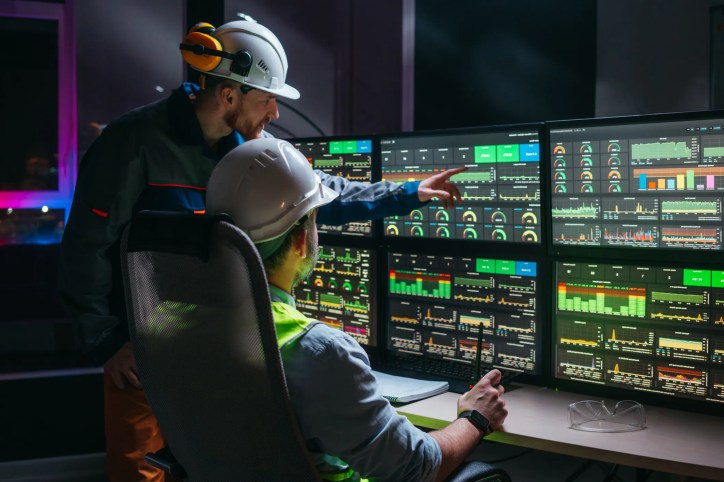When it comes to manufacturing, automotive, food & beverage, pharmaceuticals, and oil & gas, Human-Machine Interfaces (HMIs) are integral. This is because they provide operators with real-time data visualization, intuitive controls, and centralized monitoring capabilities, which significantly improve safety, efficiency, and productivity by enabling quick and informed decision-making, minimizing human error, and streamlining complex operations. ANSI/ISA 101.01-2015: Human Machine Interfaces for Process Automation Systems is a standard for designing, implementing, and maintaining HMIs for process automation systems.
What Is a Human-Machine Interface (HMI)?
A Human-Machine Interface (HMI) is a user interface or dashboard that connects a person to a machine, system, or device. It allows operators to monitor and control industrial equipment and processes in real-time. While the term can technically be applied to any screen that allows a user to interact with a device, HMI is most commonly used in the context of an industrial process, performing tasks, such as:
- Monitoring system status
- Controlling machinery
- Visualizing data from sensors and programmable logic controllers (PLCs)
- Enabling operators to respond to alarms
- Adjusting process parameters in real-time
- Tracking production time, trends, and tags
HMIs essentially act as a bridge, translating complex data from sensors and machinery into an understandable visual format and providing input mechanisms for operators to adjust parameters, optimize performance, and respond to issues, thereby improving safety, efficiency, and productivity. This aligns with the principles outlined in ANSI/ISA 101.01-2015, which standardizes how HMIs should be designed and implemented to support effective human interaction.
What Is ANSI/ISA 101.01-2015?
ANSI/ISA 101.01-2015 addresses Human Machine Interfaces (HMIs) for equipment and automated processes. It provides a comprehensive lifecycle framework, encompassing aspects from initial design to ongoing management, with key principles including enhancing situational awareness, promoting consistency, optimizing alarm management, and designing clear navigation and layouts. The aim of this American National Standard is to improve safety, quality, productivity, and reliability by assuring intuitive and effective operator interactions.
The recommendations in ANSI/ISA 101.01-2015 are applicable to any process using an HMI to interface to a control system, including but not limited to continuous, batch, and discrete processes. There may be differences in implementation to meet the specific needs based on process type.
Evolution of HMIs in Industrial Automation
While the HMI market is gaining significant traction today, predicted to grow from $5.82 billion to $11.60 billion by 2030, the evolution of HMI actually traces back to the mid-20th century, when manual controls and analog instrumentation dominated industrial settings. In these early systems, operators interacted with machinery using physical switches, dials, levers, and indicator lights. Feedback was limited and often fragmented, requiring a high level of expertise and vigilance to operate systems safely and effectively.
Rise of Programmable Logic Controllers (PLCs) & Shift to Digital Control
As industrial processes grew more complex—especially during the rise of automation in the 1960s and 70s—the limitations of purely manual interfaces became clear. The introduction of PLCs marked a pivotal turning point, enabling machines to be controlled digitally. This shift necessitated more advanced interfaces that could interpret and present data from automated systems in a clear, usable format.
Emergence of Graphical User Interfaces (GUIs)
By the 1980s and 90s, with the advent of personal computing and graphical user interfaces (GUIs), HMIs began transitioning from hardware-heavy panels to computer-based displays. Touchscreens, SCADA systems, and visual process diagrams emerged, allowing operators not just to monitor, but to interact with systems in real-time from centralized control rooms.
Modern HMIs and Industry 4.0: Smarter Interfaces for Smarter Systems
Today, modern HMIs are integral to Industry 4.0 (i.e., the ongoing automation of traditional manufacturing and industrial practices using modern digital technologies like AI, IoT, and data analytics)—incorporating high-resolution graphical displays, real-time data analytics, remote access, mobile compatibility, and even augmented or virtual reality. These advanced interfaces help operators interpret vast amounts of data, make informed decisions, and maintain control over increasingly automated and decentralized operations.
The Role of ANSI/ISA 101.01-2015 in Standardizing HMI Design
Throughout this evolution of HMIs, standards such as ANSI/ISA 101.01-2015 have emerged to guide the design, development, and deployment of effective HMIs for process automation systems —assuring they support operator performance, minimize error, and enhance safety in complex industrial environments.
ANSI/ISA 101.01-2015 is developed by the Industrial Society of Automation (ISA).
Please direct any technical questions relating to this American National Standard to the developer. You can find the contact information for all standard developing organizations (SDOs) here: Who to Contact for Standards Related Questions.
ANSI/ISA 101.01-2015: Human Machine Interfaces for Process Automation Systems is available on the ANSI Webstore.
